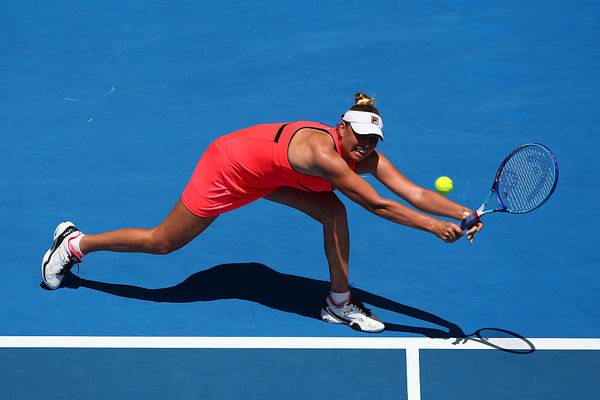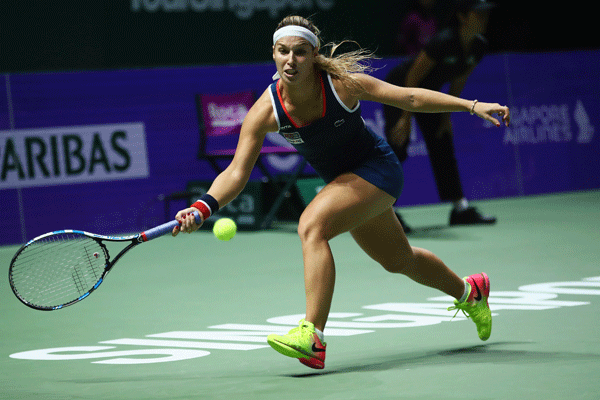US Open Tuesday: Serena Starts
NEW YORK, NY, USA – Six-time US Open champion Serena Williams leads the top half of the draw into action on Day Two at Flushing Meadows. Chris Oddo previews the action right here at wtatennis.com.
Tuesday, First Round
[1] Serena Williams (USA #1) vs. Ekaterina Makarova (RUS #29)
Head-to-head: Williams leads, 4-1
Key Stat: Williams has to reach the semifinals in New York in order to have a chance at retaining the No.1 ranking.
Serena Williams holds a remarkable 63-1 record in the first round of majors but on Tuesday she’ll be facing a player that she’d surely rather see later in the draw – if at all. In fact, the last time Williams and Ekaterina Makarova squared off it was in the semifinals of the 2014 US Open in a match that Williams won easily en route to her sixth career US Open title. Williams was dominant in that tilt, as she has been so often in a Grand Slam career that has netted her 304 wins, but her current injury status has many wondering if she can be her old dominant self in New York this year. That’s the burning question ahead of this highly anticipated tussle, and we won’t have our answer until Williams and Makarova duke it out to open Tuesday’s night session on Arthur Ashe Stadium. What we do know is that Makarova owns a win against Williams on the Grand Slam stage. The Russian defeated Williams at the 2012 Australian Open and though she’s lost the last three matches and last six sets to Williams, that victory could come in handy when it comes to Makarova’s belief. As for Williams, belief won’t be the issue. For the legendary American it will be more about getting off to a quick start and proving that she’s fit enough to go on another magical run in New York.
Pick: Williams in three
[16] Samantha Stosur (AUS #17) vs. Camila Giorgi (ITA #67)
Head-to-head: First meeting
Key Stat: 2011 US Open champion Stosur has made the second week in New York four times, including last season.
A former champion will meet up with a dangerous floater on Tuesday when Aussie Sam Stosur and Italy’s Camila Giorgi lock horns for the first time on Day 2. Giorgi can be wildly inconsistent and tends to play a somewhat one-dimensional game, but the 24-year-old can be lethal on a hardcourt if she is in the zone. She reached the round of 16 at the US Open in 2013 when she won a memorable night match against Caroline Wozniacki, and the victory proved that Giorgi has what it takes to succeed beneath the bright lights of New York. Stosur will look to serve big and hope to force a lot of Giorgi errors by using her world-class topspin to move the ball above the Italian’s strike zone. It’s the veteran Aussie’s match to lose and if she remains focused, keeps Giorgi on the run and off balance, Stosur should be able to lock down the win.
Pick: Stosur in two
[5] Simona Halep (ROU #5) vs. Kirsten Flipkens (BEL #56)
Head-to-head: Halep leads, 4-0
Key Stat: Halep has won all eight sets contested against Flipkens.
Something about this match-up works decidedly in Simona Halep’s favor. The Romanian has waltzed past Kirsten Flipkens in all four of the pair’s meetings, and she has only once dropped more than four games to Flipkens in a set. But they have not met since 2014, and Flipkens comes in with pretty good form, having just knocked off Belinda Bencic and Caroline Garcia at New Haven. Speaking of good form, Halep has won 17 of her last 19 dating back to the start of Wimbledon. The World No.5 has repeatedly stated that she is feeling fit as a fiddle and is ready to make her mark in New York. “I feel that I play good tennis,” Halep said when asked to assess her performance at Montréal and Cincinnati this year. “I’m strong on my legs. Mentally I’m very good. I think it is the best period that I had this year so far.” Concerning New York, Halep says she doesn’t need to change a thing to have success. “I’m going there just to play my best, to do my best, to win matches, and to treat the tournament like I treated [Montréal and Cincinnati].”
Pick: Halep in two
Eugenie Bouchard (CAN #39) vs. Katerina Siniakova (CZE #72)
Head-to-head: First meeting
Key Stat: Siniakova is bidding for her first US Open main draw win.
Eugenie Bouchard is back at the sight of her best and darkest days of 2015. Things were going swimmingly for Bouchard in Queens last year when she reached the round of 16 with an emotional victory over Dominika Cibulkova. It was the high point of an otherwise disappointing season for the Canadian but before she had a chance to build on her success she was out of the tournament, forced to withdraw after she suffered a concussion in a freak locker room fall. Bouchard has put together a much stronger season in 2016, but she hasn’t made the second week at any of the season’s first three majors. Can the Canadian purge her New York demons and begin another run on Tuesday? To do so she’ll have to get by 20-year-old Katerina Siniakova, a talented Czech who reached the third round of a major for the first time this summer at Wimbledon. Siniakova owns a 3-8 record at majors and she’s yet to win in Queens, which is all the more reason for her to leave it all on the court against Bouchard.
Pick: Bouchard in three
Around the Grounds…
Cincinnati champion Karolina Pliskova will square off with American wild card Sofia Kenin on Day 2. The No.10-seeded Czech has yet to reach the second round of a major in 17 previous appearances. Great Britain’s Laura Robson will look to snap a six-match losing streak at majors when she faces compatriot Naomi Broady.
By the Numbers…
72 – Number of Grand Slam main draws that Venus Williams has played in. The 36-year-old will break the all-time record, passing Amy Frazier, when she takes the court against Kateryna Kozlova of the Ukraine on Day 2.
7 – Number of finals that Serena Williams has reached in her last eight Grand Slams. The American has gone 5-2 in those finals.
4 – The number of players that entered the tournament with a shot of emerging with No.1 ranking at the end of the US Open fortnight (Serena Williams, Angelique Kerber, Garbiñe Muguruza and Agnieszka Radwanska).
304 – Serena Williams current total of Grand Slam victories are just two shy of the all-time record of 306 which is held by Martina Navratilova.








